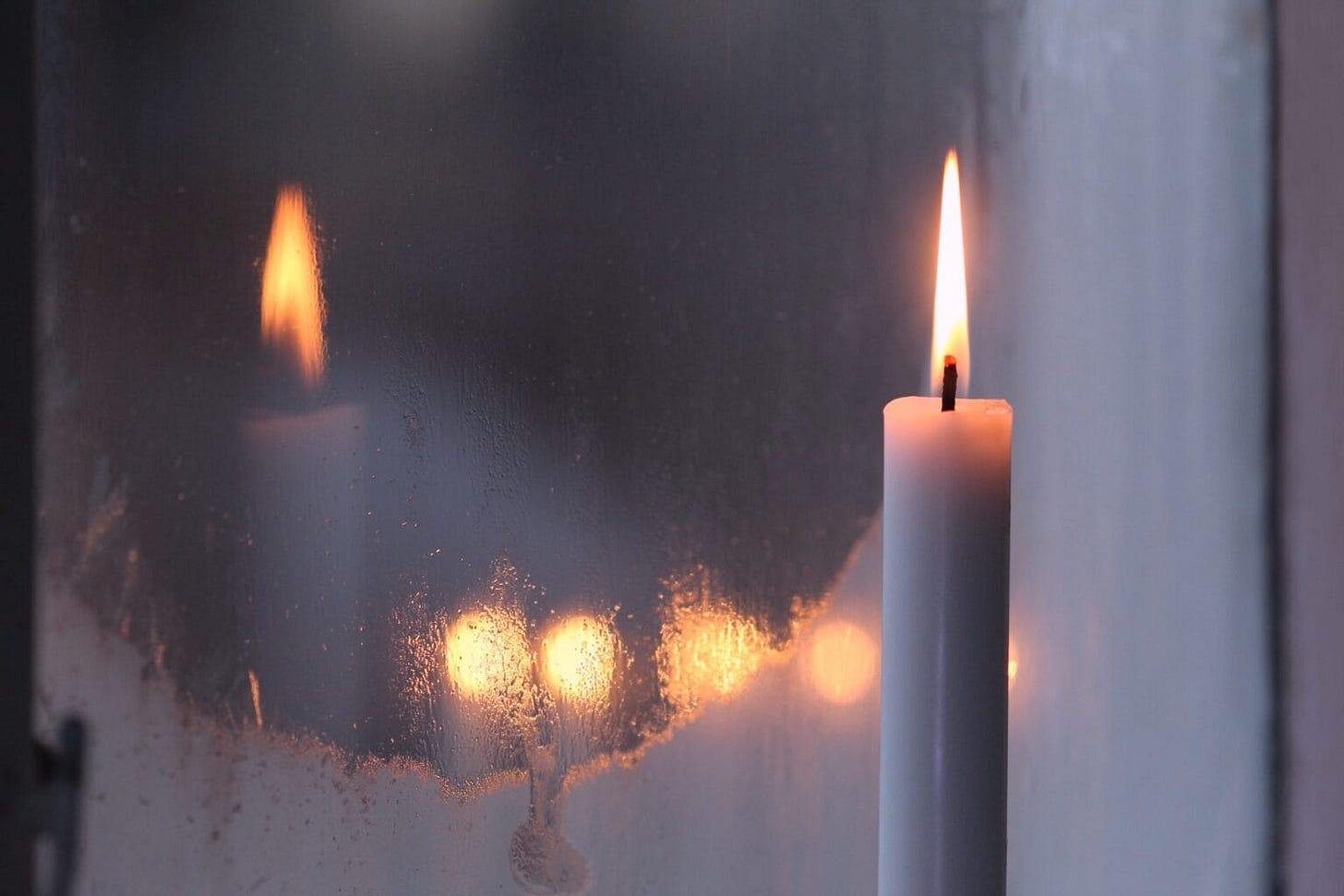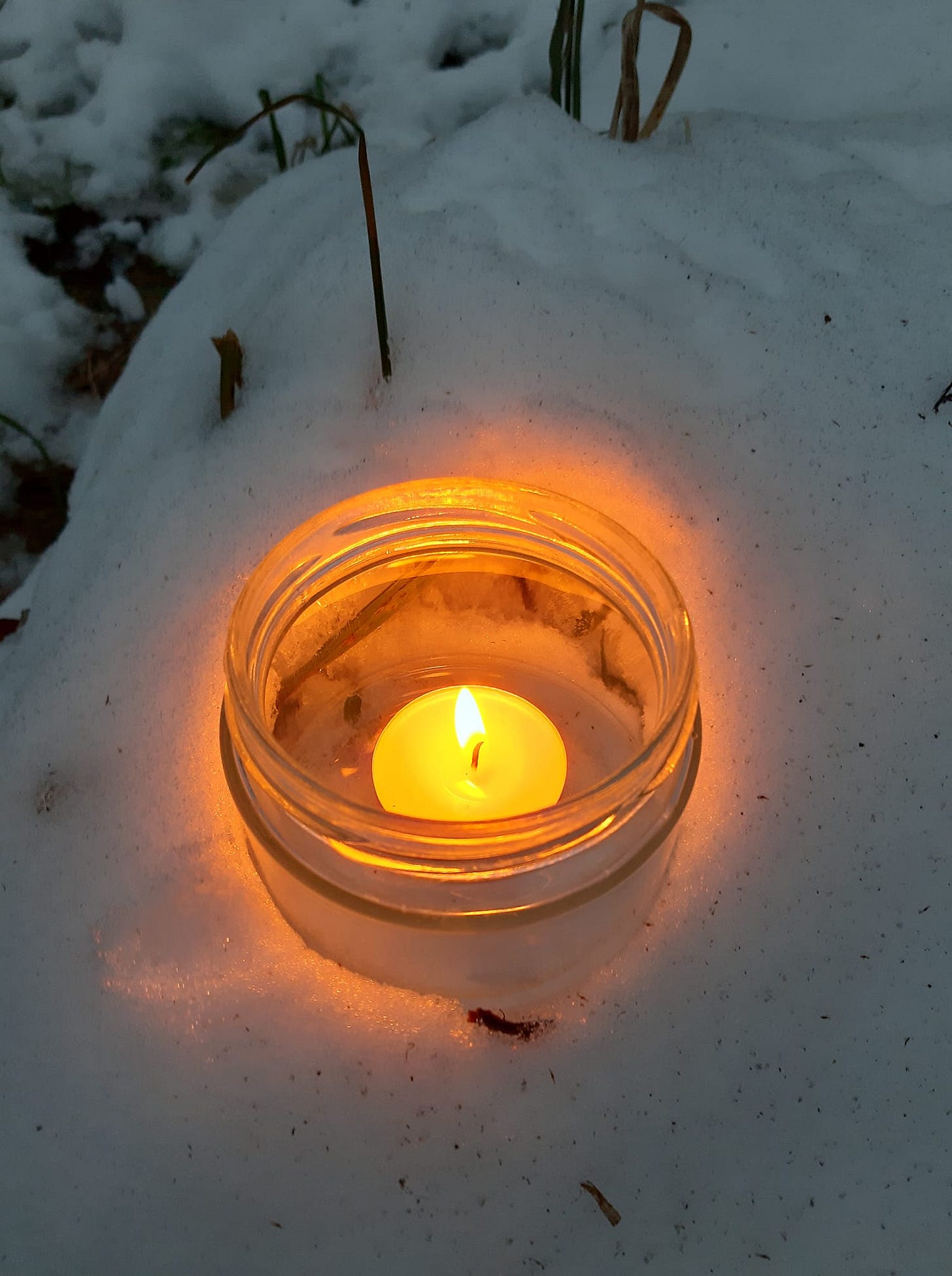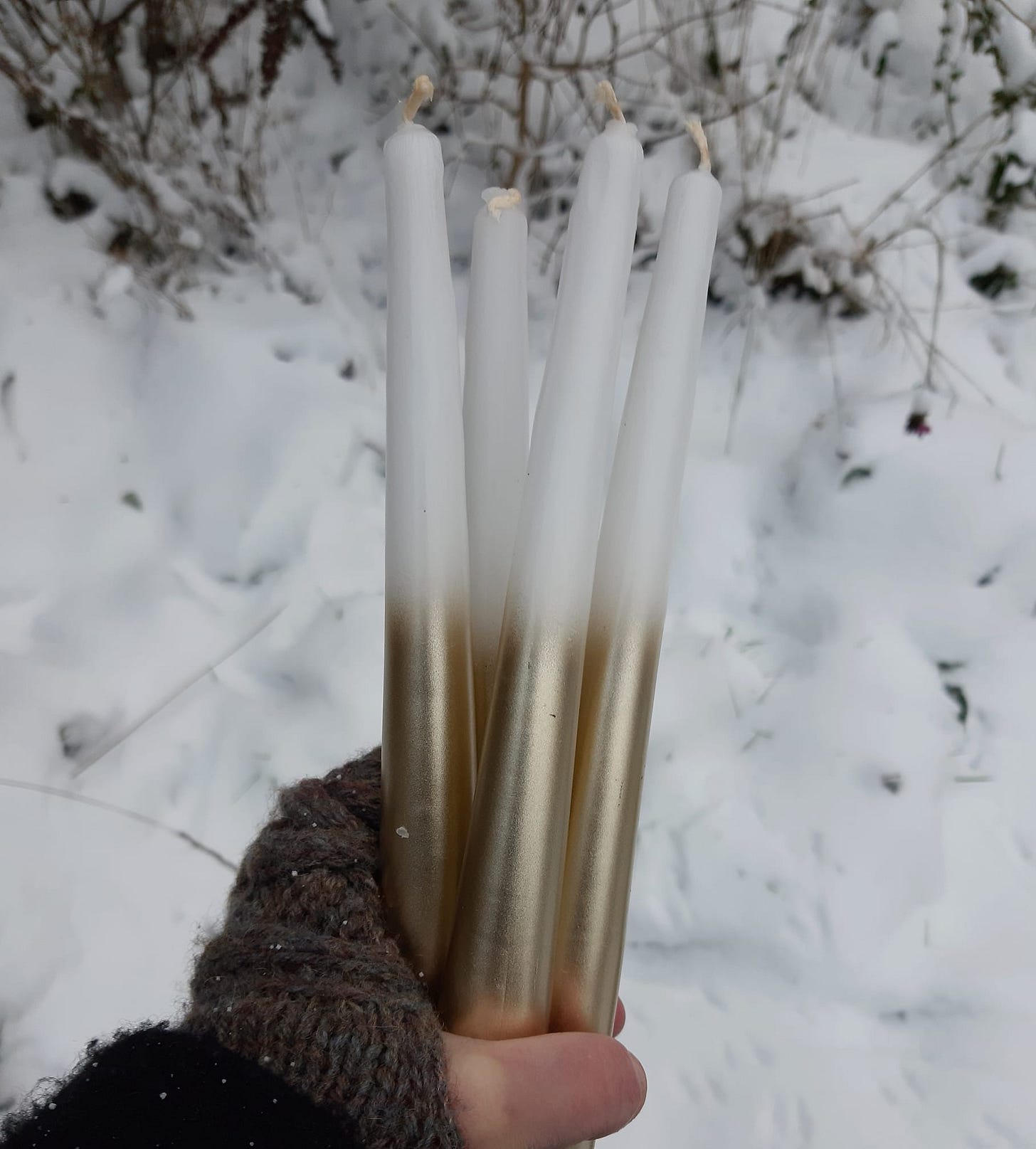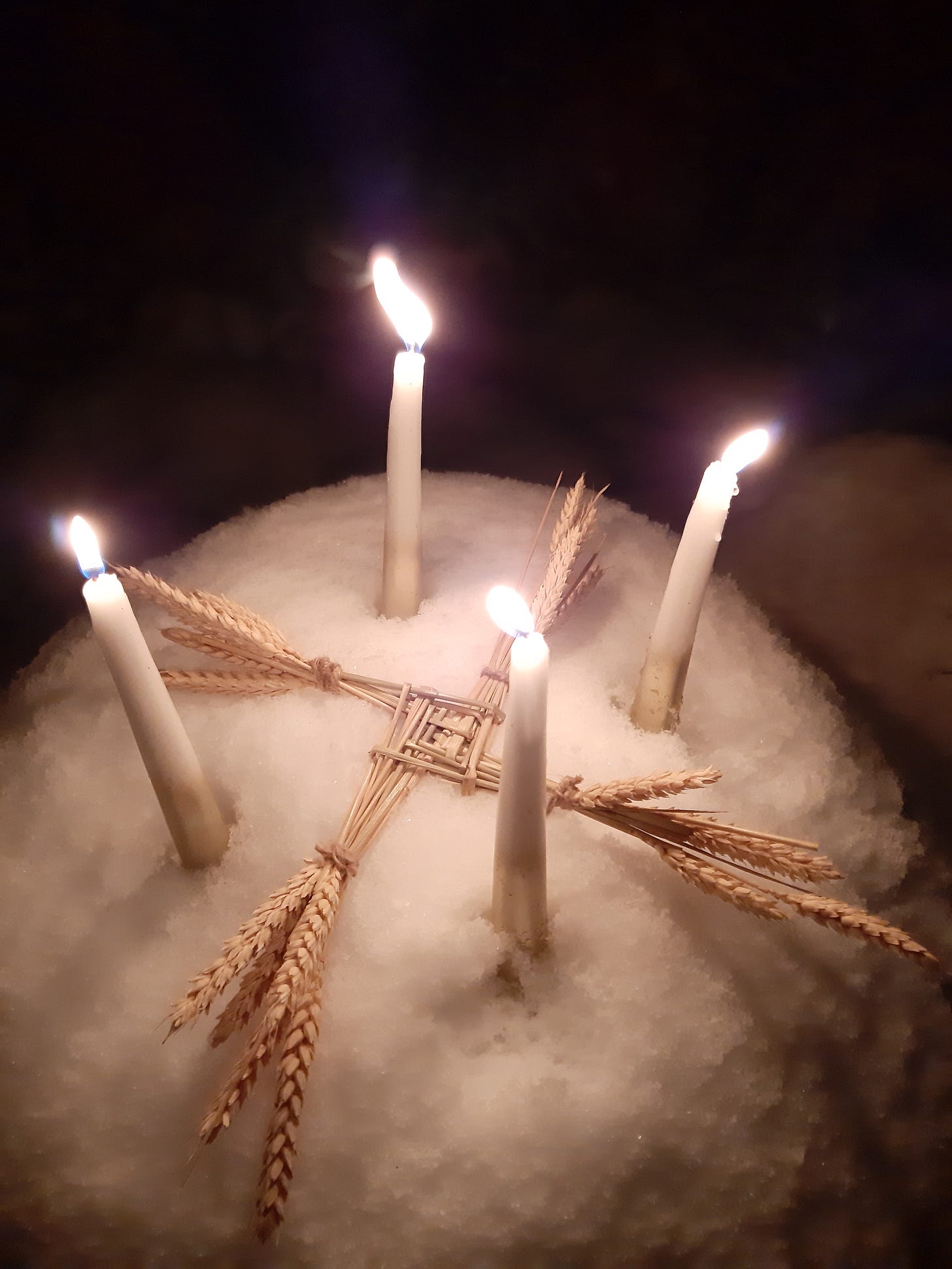“If you want to feel the sweet light flow over your body, then give yourself to light. If you want to taste the secret honey, you must allow your throat to open. Moth to candle, straw to flame, you are nothing but materials for burning.”
(Dorothy Walters)
In yesterday’s sharing for Commoners’ Advent, Reclaiming Catterntide: a Women's Winter Journey, I wrote about St Catherine’s connection to lace makers. Today, I want to turn to her as a keeper of the candle flame that takes us through the darkling months of the year. This is yet another thread that we might choose to follow as we sit in the peaceful prayer-blessed dark of the Advent Church of the Shepherd and the Shrew; that of the flame and the forge, the spark in the dark.
Let’s begin just before Catterntide with St Clement, also known in an older tongue as Old Clem the Blacksmith, whose Feast Day is on 23rd November.
The Clement who we are calling in is Pope Clement I, who was the fourth Bishop of Rome from 88 until 99CE, and who is said to have invented felt making and iron smelting, becoming the first person to ever make a horseshoe. The story of how this came to be is really quite beguiling. In 99CE he was banished by the Emperor Tarjan and forced into hard labour in a stone quarry. Against all expectations his time in the quarry was not without event. He is said to have put sheep wool into his shoes to ease his sore feet and the combination of sweat and rubbing from walking created the first felt. For that reason, St Clement is considered the patron saint of hat-makers, who subsequently declared St Clement's Eve, 22nd November, a holiday. Of course there are echoes here of St Catherine, who is also connected to hat makers and milliners.
There is some suggestion that Old Clem took the place, or is the thinly veiled remnant of, the blacksmiths' old Saxon god Wayland the Smith, who was himself a memory of the Roman god of fire, Vulcan. Indeed, one of the rhymes sung by Dartmoor blacksmiths on St Clement's Day tells us;
“Come all you Vulcans stout and strong,
Unto St. Clem we do belong,
I know this house is well prepared
With plenty of money and good strong beer,
And we must drink before we part,
All for to cheer each merry heart.”
Because of Clement’s prowess with an anvil he was adopted as the patron saint of blacksmiths who shortened his name to ‘Clem’. And so St Clement's Day became a blacksmiths' holiday where the smiths would go from door to door (or pub to pub!) carrying an effigy of 'Old Clem' & singing,
"St Clement’s Day comes once a year
Give us some apples or give us some beer!"
They would mark the day by 'firing the anvil'; filling a small hole in it with gunpowder and then hitting it with a hammer to make it explode! This not only made a great hullabaloo but also tested the anvils to make sure that they were unlikely to shatter with use.
Later, the festivities expanded to include children taking part in 'clementing'; visiting houses requesting apples, pears, or sweet treats in return for a rhyme.Activities were not confined to rural areas and, in 1541, Henry VIII passed a law forbidding children to beg for fruit, nuts, and money by catterning (for St Catherine's Day on 25th November) & clementing within the London churches of Saints Clement (of 'Oranges & Lemons' fame), Catherine, and Nicholas (who we will visit at the beginning of December). Although as the King’s edict only applied in church precincts festivities happily continued elsewhere, often accompanied by the rhyme;
“Catherine and Clement be here, be here,
Some of your apples and some of your beer;
Some for Peter, and some for Paul,
And some for Him that made us all.
Clement was good old man,
For his sake give us some,
None of the worst but some of the best,
And God will send your soul to rest!”
Sadly, clementing and the blacksmiths' holiday have waned in modern times, but St Clement's Day is still marked in Sussex and Devon with morris dancing, mulled wine, and a ‘Clem Feast’.
It's hard to imagine that any of this has much to do with the 1st Century Pope, but it is only right to offer room to the old gods woven with the new as winter begins. We will need their good company to see us through the dark.
Here's a health to the jolly blacksmith
The best of all fellows
Who works at his anvil
While the boy blows the bellows
Which makes his bright hammer
To rise and to fall
Here's to old coal, and to young coal
And to old coal of all!
(The Blacksmiths' Anthem/Twanky Dillo)
Having read about Old Clem during a previous Advent, my friend Nic Wilkinson, (@nicwilkinson.bsky.social) commented, "Of course midwinter needs a smith god to forge the new light, down there in the dark.” And here is her spellweaving for these Advent beginnings;
“Once the lighting & clementing & catterning is done…we'll have visited the Lantern Bearer, The Smith & The Lacemaker (Now St Martin, Clement, and Catherine). Gather from them what you need to walk the labyrinth of Midwinter. Which way will you go down into the old, still, expectant darkness before the light returns?”
I wrote yesterday that St Catherine, whose name means ‘pure’ or ‘light’ might be thought of as a manifestation of St Brigid, whose Old Irish name of ‘Breó-saiget’ translates as ‘fiery arrow’ or ‘bright’. As an aside, because you know that I like to dangle a thread, we will also explore Welsh St Elen during our Advent journey. She is connected to both deer and, in an even older manifestation, reindeer. Her name also means ‘light’. Light in the darkness, a flame that never quite goes out, always with us.
We will visit Brigid when we come to her feasts and festivals of Imbolc and Candlemas on the 1st and 2nd of February. Brigid is not only a Keeper of the Forge and the Hearth, but Candlemas is also the time of blessing candles for the year ahead. It feels then that there must also be an acknowledgement of candles here in the deep winter when they become so important, especially so to our ancestors as they sought to go about their winter work; the work that would ensure their survival through the cold months. And that acknowledgement comes with St Catherine and the lace makers.
Another name for the feast day of Catterntide was ‘Candle Day’ and the Cattern tea was sometimes referred to as ‘wetting the candle block’. This was because 25th November marked an important turning in the lacemakers’ year. As the first day of deep winter it was also the day when lacemakers, who often worked outdoors to make the most of the light, could legitimately go indoors and begin to use the first of their precious candles.
At this time candles were enormously expensive, the preserve of landowners and the clergy, and poor lacemakers could barely afford the light to make their intricate work possible. The absolutely wonderful ‘By the Poor, For the Rich: Lace in Context’ blog tells us of Candle Day and Cattern teas that;
“These kind of candle feasts, opening and closing the period of neighbourly winter evening work gatherings, were quite common all over Europe. Among English lacemakers the closing day of the season appears to have been Candlemas (2 February), though it was not celebrated as much as Catterns. This practice of working together to share light and heat also explains why Catterns was a communal feast. A candle-block provided light not for one lacemaker but many: a single candle would be mounted in the centre of several glass globes or flasks filled with snow-water, which would concentrate the light on the pillows of several lacemakers (the highest number of users of a single candle that we have so far encountered is eighteen!).” 1
You can see an example of the sort of candle-block that might have been used below, together with a single lacemaker making the most of her candlelight.
Another tradition was to jump over the ‘Cattern candle’, which may be where the rhyme ‘Jack be nimble’ comes from, being once sung as ‘Kit be nimble’, ‘Kit’ being a diminutive of Catherine.
“Kit, be nimble,
Kit, be quick,
Kit, jump over the candlestick.”
Thomas Wright in his ‘The Romance of the Lace Pillow:Being the History of Lace-making’, written in the 1920s, tells us that pupils of the lace school in Wendover would dance around a candlestick singing:
“Wallflowers, Wallflowers, growing up so high,
All young maidens surely have to die;
Excepting Emma Caudrey, she’s the best of all.
She can dance and she can skip,
She can turn the candlestick.
Turn, turn, turn your face to the wall again”.
before attempting to jump over a candle set in the middle of the room. If the candle flame was extinguished it would bring bad luck in the year to come.
In the 1680s, John Aubrey records Oxfordshire girls (not only lacemakers);
“…setting a candle in the middle of the room in a candlestick, and then drawing up their coats into the form of breaches, and dancing over the candle back and forth, with these words:
The tailor of Biciter [Bicester]
He has but one eye
He cannot cut a pair of green galagaskins
If he were to die.”
The Oxfordshire tradition is still recorded as taking place in the early years of the 20th Century. We might reflect too on the poor singing songs of dying in defiance of the cold and dark, as the rich preened in their warm homes wearing the products of the lacemakers’ labour. And we might too remember that our Startling God is always with those who wait for justice to come; always at the edges, never the centre where worldly power lies.
And so it is that this holy tide begins with the midwinter forge of Old Clem the Blacksmith and the candle flame of St Catherine the Lacemaker, and ends with the forge of St Brigid and the blessing of the new year’s candles as we emerge into the light at Candlemas. And all via the wild forge of a wild winter star. May we all be shaped and changed by the journey.
Let's raise a glass to Cattern and Old Clem on this Old Advent night and thank them for the brightness of their company through the dark! They have been there for longer than we know.
#CommonersAdvent #OldAdvent #CelticAdvent #StMartinsLent #WinterLent
I am determined to continue offering my work free of charge, because that too is resistance, but if you would ever like to support me with pennies you can do that at https://ko-fi.com/radicalhoneybee. Thank you so much, both for pennies and for all other forms of support, all of which are worth more than their weight in gold.
References:
Lace in Context https://laceincontext.com/tag/washing-the-candle-block/
St Catherine
https://lacemakersproject.com/jack-be-nimble-candlesticks-and-cattern-cakes/
https://liza-frank.com/24-november-2020-st-catherines-eve/
https://bmagblog.wordpress.com/2013/11/25/catterns-day/
https://annafranklinhearthwitch.wordpress.com/2020/11/23/st-catherine-goddess-of-the-wheel/
https://lacenews.net/2011/04/12/collecting-lighting-for-the-lacemaker/
Old Clem
https://en.wikipedia.org/wiki/Pope_Clement_I
https://en.wikipedia.org/wiki/St._Clement%27s_Day
https://en.wikipedia.org/wiki/Wayland_the_Smith
https://en.wikipedia.org/wiki/Vulcan_(mythology)
https://en.wikipedia.org/wiki/Anvil_firing
https://www.conviviobookworks.com/blog/sts-clem-cecilia/
https://sussexhistory.net/2016/11/20/how-to-celebrate-st-clements-day/
https://hoofcare.blogspot.com/2017/11/twanky-dillo-lost-hoof-history-saint-clement.html
https://whatliesbeyond.boards.net/thread/10413/clements-day-clems-night-november
https://www.nigeltyas.co.uk/nigel-tyas-news/post/st-clements-day.html
https://www.jstor.org/stable/1252786
https://www.certainlywood.co.uk/blogs/news/old-clem-s-night
https://sussextraditions.org/sustrad/media/FBag-Old_Clem.pdf










As is the case with everything you write Jacqueline, this is not only beautiful but offers many a thought and image to feast upon during the dark winter months. Thank you with all my heart xx
The beauty of candles and their importance to people in the past is so good to think about. I use mine willy nilly every day, not thinking about what a valuable resource they must have been. Also the candle-block….. wow, how inventive and beautiful. We live in the age of light, too much neon for me, and with the flick of a switch I think we threw out many beautiful things like the candle block! So much comes to mind from this post; fire risk, eyesight struggles, arthritic hands working away in the cold evenings and I know I have a tendency to beautify and quaintify (probably not a word!) the past but I think we humans threw many babies out with many bath waters. Thanks again. I am looking forward to your post every day. Many blessings to you for sharing all your knowledge.